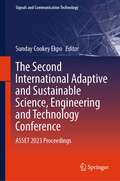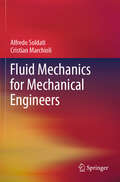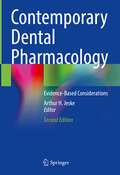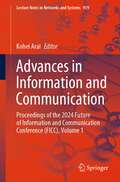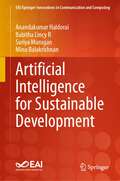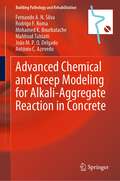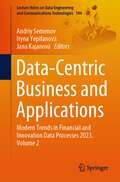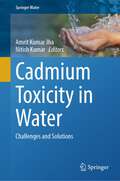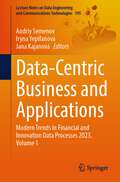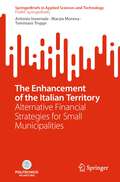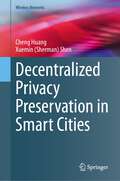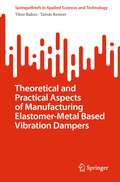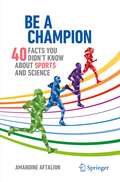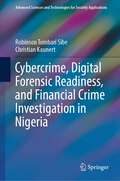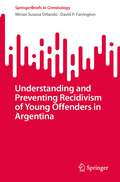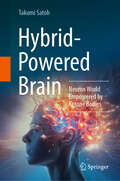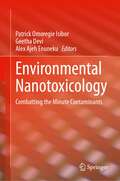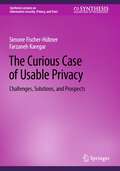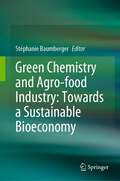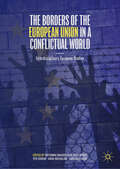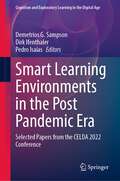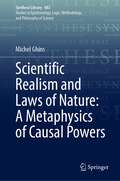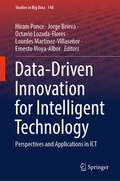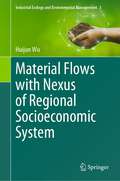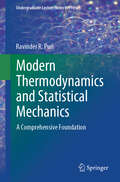- Table View
- List View
The Second International Adaptive and Sustainable Science, Engineering and Technology Conference: ASSET 2023 Proceedings (Signals and Communication Technology)
by Sunday Cookey EkpoThis proceedings presents papers from the Second International Adaptive and Sustainable Science, Engineering and Technology Conference (ASSET 2023), which took place simultaneously in Manchester, UK and Ikot Akpaden, Nigeria on 18-20, July 2023. The ASSET conference serves as an interactive forum for the advancement of the practice of adaptive and sustainable systems across the multiple disciplines and specialty areas involved with the science, engineering, and technology of integrated entities, complex systems, and networks. The conference provides an avenue for practitioners, researchers, managers, developers, analysts, educators, and users to exchange innovative ideas, concepts, applications, and lessons learned in addressing domain-specific problems, applications-oriented topics, methodologies, standards and multidisciplinary research opportunities and findings relating to ASSET systems.
Fluid Mechanics for Mechanical Engineers
by Alfredo Soldati Cristian MarchioliThis textbook describes the fundamentals of the phenomena of fluid dynamics in the context of engineering instances. It is designed to replace introductory books and notes on the subject for first-level engineering courses as well as higher-level courses or for professional use. The use of this book requires the basic knowledge of mathematics and physics normally delivered in the early years of undergraduate study. However, the extensive use of examples and solved exercises proposes a parallel intuitive route to understanding the necessary mathematical formalisms. It proves that a new fluid dynamics text should not contain new ideas or formalisms, but should present the material in a modern and intuitive way. The approach chosen is primarily practical, so that that readers can practice by solving the proposed problems and examples in order to be prepared to solve the new problems they will encounter in their academic and professional activities. It serves as a teaching tool for coursesin basic fluid dynamics, advanced fluid dynamics, turbulence, and aerodynamics.
Contemporary Dental Pharmacology: Evidence-Based Considerations
by Arthur H. JeskeThis book on current approaches to the use of drugs in dentistry, now in an extensively revised second edition, aims to equip practitioners with a sound understanding of both the scientific evidence for various interventions and the comparative efficacy of those interventions. The focus is on the drugs most commonly used in conjunction with dental treatment, including local anesthetics, analgesics, antibiotics, sedatives, and drugs for the management of medical emergencies. Summaries of the scientific evidence from the available published literature are provided, with assessment of the level and quality of the evidence base. A unique aspect of the book is its focus on current, evidence-based recommendations from professional organizations with regard to special topics, such as antibiotic prophylaxis, pediatric considerations, and management of medically compromised patients. Emphasis is placed on evidence from randomized controlled trials, systematic reviews and meta-analyses,and in order to further enhance the up-to-date nature of the book, each chapter includes guidance on online resources, such as useful non-commercial websites.
Advances in Information and Communication: Proceedings of the 2024 Future of Information and Communication Conference (FICC), Volume 1 (Lecture Notes in Networks and Systems #919)
by Kohei AraiThe book is a valuable collection of papers presented in the Future of Information and Communications Conference (FICC), conducted by Science and Information Organization on 4–5 April 2024 in Berlin. It received a total of 401 paper submissions out of which 139 are published after careful double-blind peer-review.Renowned and budding scholars, academics, and distinguished members of the industry assembled under one roof to share their breakthrough research providing answers to many complex problems boggling the world. The topics fanned across various fields involving Communication, Data Science, Ambient Intelligence, Networking, Computing, Security, and Privacy.
Artificial Intelligence for Sustainable Development (EAI/Springer Innovations in Communication and Computing)
by Anandakumar Haldorai Babitha Lincy R Suriya Murugan Minu BalakrishnanThis book delves into the synergy between AI and sustainability. This comprehensive guide illuminates the latest trends and cutting-edge techniques, offering invaluable insights for researchers, practitioners, and policymakers interested in the cross-section of AI and sustainability. The authors illustrate how AI-driven innovations are revolutionizing environmental conservation, urban planning, healthcare, and more. The book also considers the ethical considerations and governance frameworks crucial to harnessing AI's potential for global benefit. Whether a seasoned expert or a curious newcomer, this book empowers readers to navigate the dynamic landscape of AI and sustainability, paving the way for a more eco-conscious and equitable world.
Advanced Chemical and Creep Modeling for Alkali-Aggregate Reaction in Concrete (Building Pathology and Rehabilitation #28)
by Fernando A. Silva Rodrigo F. Roma Mohamed K. Bourbatache Mahfoud Tahlaiti João M. Delgado António C. AzevedoThis book presents the numerical results of the use of the chemical model to analyse the advancement of the reaction and the mechanical model to simulate creep and shrinkage phenomena in COMSOL Multiphysics®, as a way to reassess concrete structures suffering from those mechanisms. Both models were implemented separately to evaluate their responses and compare them with the theoretical results and experimental benchmarks presented in the literature. The numerical simulation results showed excellent agreement with the experimental results data, with maximum disagreement not exceeding 10%, indicating that the implementation of the developed numerical models behaved very efficiently.
Data-Centric Business and Applications: Modern Trends in Financial and Innovation Data Processes 2023. Volume 2 (Lecture Notes on Data Engineering and Communications Technologies #194)
by Andriy Semenov Iryna Yepifanova Jana KajanováThis book examines aspects of financial and investment processes, as well as the application of information technology mechanisms to business and industrial management, using the experience of the Ukrainian economy as an example. An effective tool for supporting business data processing is combining modern information technologies and the latest achievements in economic theory. The variety of industrial sectors studied supports the continuous acquisition and use of efficient business analysis in organizations. In addition, the book elaborates on multidisciplinary concepts, examples, and practices that can be useful for researching the evolution of developments in the field. Also, in this book, there is a description of analysis methods for making decisions in business, finance, and innovation management.
Cadmium Toxicity in Water: Challenges and Solutions (Springer Water)
by Amrit Kumar Jha Nitish KumarThis book sheds light on this global environmental issue and proposes solutions to reduce contamination through multi-disciplinary approaches. Water is considered a vital resource because it is necessary for all aspects of human and ecosystem survival. However, due to natural processes and anthropogenic activities, various pollutants have been added to the groundwater system. Among these, heavy metals are some of the most serious pollutants. Cd, a toxic heavy metal used in Ni-Cd batteries, the coloration of plastic and various discarded electronic products released into the water system causes serious health issues. The chronic exposure to Cd produces a wide variety of acute and chronic effects in humans.This edited book brings together a diverse group of researchers to address the challenges posed by global mass poisoning caused by cadmium contamination of water bodies. This book contains three sections. The first section describes the different sources and distribution of cadmium in water ecosystem. The second section explains the health risks linked to cadmium toxicity. The third section addresses sustainable cadmium toxicity mitigation strategies and the potential applications of recent biological technology in providing solutions.
Data-Centric Business and Applications: Modern Trends in Financial and Innovation Data Processes 2023. Volume 1 (Lecture Notes on Data Engineering and Communications Technologies #195)
by Andriy Semenov Iryna Yepifanova Jana KajanováThis book examines aspects of financial and investment processes, as well as the application of information technology mechanisms to business and industrial management, using the experience of the Ukrainian economy as an example. An effective tool for supporting business data processing is combining modern information technologies and the latest achievements in economic theory. The variety of industrial sectors studied supports the continuous acquisition and use of efficient business analysis in organizations. In addition, the book elaborates on multidisciplinary concepts, examples, and practices that can be useful for researching the evolution of developments in the field. Also, in this book, there is a description of analysis methods for making decisions in business, finance, and innovation management.
The Enhancement of the Italian Territory: Alternative Financial Strategies for Small Municipalities (SpringerBriefs in Applied Sciences and Technology)
by Antonio Invernale Marzia Morena Tommaso TruppiThis book presents some alternative models and financial instruments for the enhancement of public properties and urban regeneration operations. Set against the backdrop of the current scenario of competition between cities to attract investments (but also of cooperation in front of challenges posed by sustainable development issues), the book describes the role played by Public Administrations through the measurement and comparison of their efficiency in the bureaucratic procedures in the field of real estate and their knowledge and use of some alternative financial tools, particularly civic crowdfunding. Following a brief overview of public-private partnership, the book highlights the potentialities of civic crowdfunding for the enhancement of public real estate assets in the Italian territory, related to small municipalities, also including some case studies. These good practices prove civic crowdfunding a useful tool not only to finance and implement public interest initiatives, but also to transparently and directly involve citizens.
Decentralized Privacy Preservation in Smart Cities (Wireless Networks)
by Cheng Huang Xuemin (Sherman) ShenThis book investigates decentralized trust-based privacy-preserving solutions in smart cities. The authors first present an overview of smart cities and privacy challenges and discuss the benefits of adopting decentralized trust models in achieving privacy preservation. The authors then give a comprehensive review of fundamental decentralized techniques and privacy-preserving cryptographic techniques. The next four chapters each detail a decentralized trust-based scheme, focusing respectively on privacy-preserving identity management, cross-domain authentication, data analytics, and data search, in specific use cases. Finally, the book explores open issues and outlines future research directions in the field of decentralized privacy preservation.
Theoretical and Practical Aspects of Manufacturing Elastomer-Metal Based Vibration Dampers (SpringerBriefs in Applied Sciences and Technology)
by Tibor Babos Tamás RennerThis book offers a comprehensive breakdown of rubber industry procedures, serving as an invaluable resource for enhancing professional literacy. It covers measurable technological parameters, manufacturing processes, and metallurgy of the materials required for producing high-value rubber-metal machine components. These components find wide applications in the engineering industry, including buffers, vibration damping elements, pipe expansion joints, and silent blocks (vibration dampers vulcanized between steel pipes). The manufacturing of modern machine components necessitates meeting high technical standards and ensuring flawless performance throughout their lifetime. This goal is accomplished by manufacturing components to the required technical parameters with consistent quality specified during the design stage. Unfortunately, scientific descriptions of rubber-metal bonding technologies often lack the detail required for practical application. This book addresses this gap by presenting extensive research conducted by Renner Rubber Products, a key player in the rubber market in Central Europe, drawing on practical experience from the Centre for Security Studies at the Hungarian University of Agriculture and Life Sciences. The book provides a set of technological specifications for rubber-metal bonding based on experiments, measurements, calculations, and proven research results. A noteworthy aspect of the book is that it is the result of close scientific collaboration between academia and industry-leading players, resulting in a highly qualified product applicable in science, academia, and industrial production alike. It serves as a valuable tool for anyone in the engineering industry seeking to enhance their understanding of rubber industry procedures and produce high-quality rubber-metal machine components.
Be a Champion: 40 Facts You Didn't Know About Sports and Science (Copernicus Books)
by Amandine AftalionWhy do you lean in a bend? Why does a sprinter slow down before the finish line? Why do golf balls have dimples? Why do you swim better slightly underwater? Why, on a bike, the faster you go, the more stable you are? Why shouldn’t you rely on doping tests too much? Is there a law of evolution of records?These are some of the 40 questions that Amandine Aftalion answers in this book using simple physics and mathematics, and some humor. Not only will it allow you to improve yourself in sports, but it will also but it will also give way to understanding how champions do.An easy book to read and the must to have if you are a sports addict or if you watch sports on TV and ask yourself “why?”.Amandine Aftalion is a French mathematician. She is a CNRS senior scientist and graduated from École normale supérieure in Paris. She has given talks all over the world, as a specialist of models coming from low temperature physics. She has written a book on vortices in Bose–Einstein condensates. More recently, she has used energy minimization to study an optimal control problem coming from human energy: optimizing running. She has written papers on sports aimed at coaches. Part of her latest results have inspired the first chapter of this book. She is the producer and director of a French YouTube channel for the popularization of mathematics, Videodimath, elected as one of the 5 best French YouTube channels for popular mathematics.
Cybercrime, Digital Forensic Readiness, and Financial Crime Investigation in Nigeria (Advanced Sciences and Technologies for Security Applications)
by Robinson Tombari Sibe Christian KaunertNigeria has become one of the hotbeds of cybercrime since the liberalization of the telecommunication industry began in 1996. The scale and magnitude have been quite disturbing, not just for Nigeria but also for the international community, given the limitless boundaries of cybercrime. Like any other type of fraud, Internet fraud is primarily driven by financial gains. This book investigates the extent of the lack of digital forensic resources in Nigeria’s financial crime agencies. It is vital to have a proper resource inventory and capabilities to successfully confront the growing threat of financial crimes. While a few studies have suggested the lack of forensic capabilities in Nigerian cybercrime investigative agencies and the justice system, none have examined this in great detail, particularly in relation to specific skills gaps and resources needed in Nigeria’s financial crime agencies. This book contributes to the growing body of knowledge and clarifies the scope of the lack of digital forensic resources. Understanding the extent of the deficiency and its impact on caseloads could be crucial for developing a roadmap toward building forensic readiness and capability maturity for the agencies. This book presents the deficiencies in forensic readiness and recommends measures to fill this gap. This book also examines the specifics of the cybercrime caseloads and conviction records in Nigeria, identifying trends and patterns. The book explores other cybercrime complexities in Nigeria, such as common cybercrime taxonomies, prosecution, and conviction dynamics, juxtaposing it with select case studies in other jurisdictions. Drawing on extensive research, the book offers crucial insights for policymakers, researchers, and the public interested in new trends in cybercrime, digital forensic readiness, Nigerian financial crime agencies, and cybercrime investigations.
Understanding and Preventing Recidivism of Young Offenders in Argentina (SpringerBriefs in Criminology)
by Mirian Susana Orlando David P. FarringtonThis book aims to advance knowledge about the recidivism of young offenders. It reviews knowledge about risk factors for recidivism and about protective factors that encourage desistance. It then reviews quantitative research on predictors of recidivism versus desistance of young offenders in Buenos Aires, Argentina, based on following up over 100 young offenders during a two-year statutory monitoring period. Numerous factors are identified that predict recidivism: family, educational, social, community, demographic, offence history, substance use history. It then presents qualitative research based on offenders’ narratives, using extensive verbatim quotations, that explain their recidivism versus desistance. Finally, it reviews research on the prevention of recidivism of young offenders and makes recommendations based on the quantitative and qualitative analyses. This book should be of great interest to all academics, researchers, practitioners and policy makers who are interestedin juvenile offending and recidivism, including criminologists, psychologists, psychiatrists, social scientists and criminal justice practitioners.
Hybrid-Powered Brain: Neuron World Empowered by Ketone Bodies
by Takumi SatohThis book unlocks the secrets of a powerful and sustainable brain, as well as explores the concept of a hybrid-powered brain and the transformative potential of the "Small Ketogenic" system.Supplying the brain with an ample energy substrate is vital for a positive mindset and a fulfilling day. Adequate energy fuels sharp thinking and clear judgement, while an energy-deficient brain leads to a variety of problems. Low blood glucose levels make it difficult to remember and amplify negative emotions. Delve into the brain's often-overlooked energy system to avoid these situations.The human brain functions on two energy systems: glucose from carbohydrates and ketone bodies from fats. These systems complement each other, and activating the hybrid system is surprisingly simple. Adopting the "Small Ketogenic" means extending the intervals between meals and allowing for a slight feeling of hunger within a reasonable range. This approach preserves cognitive function to the maximum.Inspired by the longevity of individuals in certain villages, the hybrid-powered brain enhances mental vitality. These villagers lead vibrant lives fuelled by their powerful minds. Maintaining ketone body concentrations between 0.2-0.5 mM ensures an active and calm brain. By making slight adjustments in eating habits, and adopting the "Small Ketogenic", we can achieve healthy longevity. This sustainable approach boosts the brain and promotes optimal health effects.Embark on a transformative journey of self-improvement and discover the true potential of your brain. This book revolutionises the way you perceive and care for your brain, leading you to a sustainable and fulfilling cognitive existence.
Environmental Nanotoxicology: Combatting the Minute Contaminants
by Patrick Omoregie Isibor Geetha Devi Alex Ajeh EnunekuEnvironmental Nanotoxicology: Combatting the Minute Contaminants is a comprehensive guide to the rapidly evolving field of nanotoxicology and its implications for environmental health and safety. This book results from the collaborative efforts of leading experts and researchers from diverse disciplines, aiming to thoroughly understand the interactions between nanomaterials and the environment and their potential impacts on the delicate balance of our ecosystems.Nanotechnology has witnessed remarkable innovations leading to the development of nanomaterials with novel properties and applications across various industries. Alongside these innovations, concerns have arisen about the potential risks that nanomaterials may pose to the environment and living organisms. This book addresses these concerns by comprehensively exploring the field's key concepts, principles, and methodologies. It includes case studies and offers insights into developing appropriate regulatoryframeworks and guidelines for the responsible use and disposal of nanomaterials. The book is a valuable resource for researchers and professionals working in nanotoxicology on the complex challenges posed by the intersection of nanomaterials and the environment. It is also an essential reference for students studying environmental science, toxicology, and nanotechnology.
The Curious Case of Usable Privacy: Challenges, Solutions, and Prospects (Synthesis Lectures on Information Security, Privacy, and Trust)
by Simone Fischer-Hübner Farzaneh KaregarThis book journeys through the labyrinth of usable privacy, a place where the interplay of privacy and Human-Computer Interaction (HCI) reveals a myriad of challenges, solutions, and new possibilities. Establishing a solid understanding of usable privacy research, practices, and challenges, the book illuminates for readers the often shadowy corridors of such a multifaceted domain and offers guidelines and solutions to successfully traverse the challenging maze. The book does not simply focus on data protection or legislative frameworks but also on what it takes for privacy to be safeguarded, understood, embraced, and easily practiced by all. It begins with a thorough exploration of the background of privacy tools and technologies, the evolution of privacy rules and regulations, and the backdrop upon which this narrative unfolds. After establishing this context, its next important focus is the current state and future directions of the field, including thefrontiers of usable privacy research in relation to the Internet of Things (IoT), usability of PETs, and usable privacy for UX and software developers. The book also considers the often-overlooked privacy narratives of marginalized communities and delves into the complexities of user-centric privacy. Readers are provided with a blueprint for addressing these hurdles and establishing pathways for a more privacy-conscious world. The text will be of interest to students studying Computer Science, Information Systems, or Law, as well as researchers and practitioners working in the fields of usable privacy, privacy by design, Privacy-Enhancing Technologies (PETs), or HCI. All will benefit from the book’s central deliberation of a question that echoes through time and technological advancements: why does usable privacy matter?
Green Chemistry and Agro-food Industry: Towards a Sustainable Bioeconomy
by Stéphanie BaumbergerThe objective of the book is to show the complementarity and integration of food and non-food value chains for the development of a sustainable bioeconomy. One current challenge facing industry and the economy is to meet the needs of a growing world population while preserving the environment. The use of fossil energy resources for several decades has generated a decrease in reserves of these resources, together with a phenomenon of global warming due to the release of greenhouse gases into the atmosphere. More and more industrial sectors, including the chemical industry, are replacing fossil carbon with renewable carbon. The bioeconomy consists in using renewable biological resources to produce food, materials, and energy. A bioeconomy based on the green chemistry and biotechnologies is developing worldwide, as a lever for reducing the ecological footprint of human activities. The book is articulated around six parts, each dedicated to a keystone of the interface betweengreen chemistry and Agro-Food Industry.
The Borders of the European Union in a Conflictual World: Interdisciplinary European Studies
by Antonina Bakardjieva Engelbrekt Per Ekman Anna Michalski Lars OxelheimThis open access book examines the implications for the EU of a radically changed international context characterized by systemic rivalry, competition over norms and regulations, and growing strategic tension. Globalization that once tied national economies together and internationalized social phenomena, such as education, research and innovation, and tourism, has gone in reverse. An opposite trend is driving the world into distinct spheres of competing models of governance, regulation, technological development, and communication. Facing the most extensive rupture of economic and inter-state relations since the onset of the Cold War, the management of the EU’s internal and external borders is taking on a completely new meaning. The open access book brings together scholars from economics, law, and political science to provide up dated assessments and policy advice on the insecurity in the neighborhood and war in Ukraine, the EU’s role in the future European security architecture,weaponized energy dependence, and the global competition on norms.
Smart Learning Environments in the Post Pandemic Era: Selected Papers from the CELDA 2022 Conference (Cognition and Exploratory Learning in the Digital Age)
by Demetrios G. Sampson Dirk Ifenthaler Pedro IsaíasThis edited volume presents the latest research focussing on current challenges on the deployment of smart technologies and pedagogies for supporting teaching and learning in the post-covid19 era. This is at the core of studying the evolution of the learning process, the role of technology-supported pedagogical approaches, and the progress of educational technology innovations in the context of digital transformation in education and professional training. A selection of the best papers from the Cognition and Exploratory Learning in the Digital Age (CELDA) Conference, 2022 are included in this volume, bringing together high-quality research on Smart Pedagogies in the Post-Pandemic Era; Smart Learning Technologies in the Post-Pandemic Era; and Case Studies of Smart Learning Environments. The volume contributes to the discussion of current issues in digital education between researchers, practitioners, and policymakers.
Scientific Realism and Laws of Nature: A Metaphysics of Causal Powers (Synthese Library #483)
by Michel GhinsThis book addresses central issues in the philosophy and metaphysics of science, namely the nature of scientific theories, their partial truth, and the necessity of scientific laws within a moderate realist and empiricist perspective. Accordingly, good arguments in favour of the existence of unobservable entities postulated by our best theories, such as electrons, must be inductively grounded on perceptual experience and not their explanatory power as most defenders of scientific realism claim. Similarly, belief in the reality of dispositions such as causal powers which ground the natural necessity of scientific laws must be based on experience. Hence, this book offers a synthetic presentation of an original metaphysics of science, namely a metaphysics of properties, both categorical and dispositional, while at the same time opposing strong versions of necessitarism according to which laws are true in all possible worlds.The main theses and arguments are clearly presentedin a non-technical way. Thus, on top of being of interest to the specialists of the topics discussed, it is also useful as a textbook in courses for third year and more advanced university students.
Data-Driven Innovation for Intelligent Technology: Perspectives and Applications in ICT (Studies in Big Data #148)
by Hiram Ponce Jorge Brieva Octavio Lozada-Flores Lourdes Martínez-Villaseñor Ernesto Moya-AlborThis book focuses on new perspectives and applications of data-driven innovation technologies, applied artificial intelligence, applied machine learning and deep learning, data science, and topics related to transforming data into value.It includes theory and use cases to help readers understand the basics of data-driven innovation and to highlight the applicability of the technologies. It emphasizes how the data lifecycle is applied in current technologies in different business domains and industries, such as advanced materials, healthcare and medicine, resource optimization, control and automation, among others.This book is useful for anyone interested in data-driven innovation for smart technologies, as well as those curious in implementing cutting-edge technologies to solve impactful artificial intelligence, data science, and related information technology and communication problems.
Material Flows with Nexus of Regional Socioeconomic System (Industrial Ecology and Environmental Management #3)
by Huijun WuThis book introduces and integrates material flows with their nexuses in the regional socioeconomic system, to explore the environmental impacts of the system. Currently, many related studies conducted on global and country levels focus on the direct material flows including material inputs and outputs of the socioeconomic system. While they seldom consider the indirect flows derived from the nexus relationships among these materials, especially on the regional levels. This book concerns the regional differences and highlights the integration of material flows as well as their nexuses in the regional socioeconomic system. It tries to systematically analyze the environmental impacts of the system, clearly explain the relationship between socioeconomic system and natural environment, and provide the reference to achieve the sustainable development for different regions.
Modern Thermodynamics and Statistical Mechanics: A Comprehensive Foundation (Undergraduate Lecture Notes in Physics)
by Ravinder R. PuriThis undergraduate-level textbook offers a unique and in-depth approach to the study of thermodynamics and statistical mechanics. It covers the fundamentals of thermodynamics using both traditional and postulatory approaches, including origin of the concept of thermodynamic entropy, Euler’s equation, Gibbs-Duhem relations, stability of equilibrium, and the concept of thermodynamic potentials, and that of independent thermodynamic observables. The book then delves into the microscopic foundation of thermodynamics, starting with the kinetic theory and highlighting its historical development. Boltzmann's concept of entropy is explored, along with its applications in deriving Planck’s, Bose’s, Bose-Einstein, and Fermi-Dirac distribution functions. The formal structure of classical and quantum statistical mechanics is built based on the concept of statistical entropy and the maximum entropy principle and used to investigate in detail the thermodynamic properties of ideal classical and quantum systems. The book also covers phase transitions, simple theory of critical phenomena, and the theory of interacting van der Waals gases. Throughout the text, the book provides historical context, enriching the reader's understanding. This textbook is a valuable resource for undergraduate physics students, offering comprehensive coverage, including overlooked topics, and a historical perspective on thermodynamics and statistical mechanics.
